Today we will learn about ultrasonic welding principle, working, equipment’s application, advantages and disadvantages with its diagram. Ultrasonic welding is a welding process in which ultrasonic waves or vibrations are used to generate heat for welding. Ultrasonic means those vibration waves which have frequency above the normal hearing range. It is about 20000 to 30000 Hz. It is a solid state welding process. Solid state welding is a welding process in which no external heat is added for welding.
Ultrasonic Welding:
Principle:
It works on the basic principle of energy of ultrasonic wave. Ultrasonic vibration creates a dynamic shear stress between the contacts of two work piece. Due to local plastic deformation and heat generate due to friction between contact surfaces, joint formation will take place at the interface.
Equipment’s:
Power Supply:
The ultrasonic welding needs high frequency and high voltage power supply. This power is needed by the transducer to generate vibrations.
Transducer:
Transducer is a device which can convert high frequency electric signal into high frequency mechanical vibration. This is connected with the welding head. The converter or piezoelectric transducer used in this welding process.
Booster and Horn:
The mechanical vibration created by the transducer is supplied to the booster which amplifies this vibration and supply to the horn. Horn is a device which supply this amplified vibration to the welding plates.
Fixture or clamping devices:
This device is essential in the ultrasonic welding. This uses either electrical, hydraulic, pneumatic or mechanical energy to hold the plates into desire location.
Working:
Now we know the basic concept of ultrasonic welding. This welding works as follow.
- At the start, high frequency current passes through a piezoelectric transducer. This transducer converts high frequency electrical signal into mechanical vibration.
- This vibration further supplied to the booster which amplify its frequency.
- The amplified high frequency vibration passes through horn which is in contact with welding plate.
- This welding creates lap joint. One plant of the weld is fixed into fixture and other one is in direct contact with horn. These plates are fixed under moderate pressure force.
- The horn supply high frequency mechanical vibration to the welding plate.
- Due to this vibration, oscillation shear force act at the interface between welding plates which result elestoplastic deformation at interface.
- It also create a localize temperature rise due to mechanical force and friction. This heat helps in plastic deformation at interface and makes a strong joint without melting of work piece or using filler metal.
This working can be easily understandable by following video.
Advantages and Disadvantages:
Advantages:
- This welding can be easily automated and fast.
- This produces high strength joint without applying external heat.
- This is clean and provides good surface finish after welding.
- Ultrasonic process used to weld wide variety of dissimilar metal.
- It does not develop high heat so there is no chance of expel molten metal form joint.
Disadvantages:
- It does not weld thick harder metal. The thickness of welds about 2.5 mm for aluminum.
- Tooling cost for fixture is high and they also need special design.
- The vibration generates through transducer, can damage electronic component.
Applications:
- This welding is used in fabrication of nuclear reactor components.
- It is used in automotive industry for key, head lamp parts, button and switches etc.
- Ultrasonic is used in electronic industries like armature winding, switches etc.
- This is clean welding process so it is used in medical industries to make parts like filters, masks etc.
This is all about ultrasonic welding principle, working, equipment’s, application, advantages and disadvantages with its diagram. If you have any query regarding this article, ask by commenting. If you like this article, don’t forget to share it on your social networks. Thanks for reading it.Image Source : http://science.howstuffworks.com/ultrasonic-welding1.htm

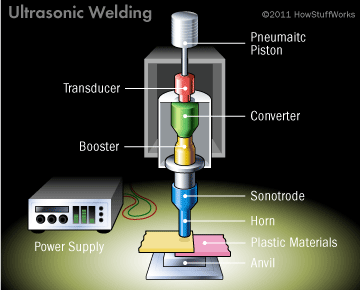
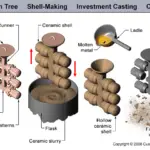
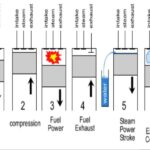

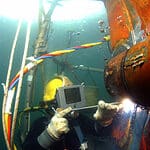
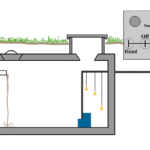

“Good day! This is my first visit to your blog! We are a team of volunteers and starting a new initiative in a community in the same niche.
Your blog provided us valuable information to work on. You have done a wonderful job”
It’s in reality a great and helpful piece of information. I am glad that you shared this useful info with us. Please keep us informed like this. Thank you for sharing.|